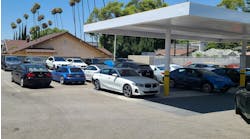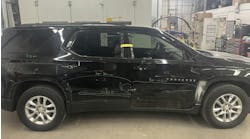Waterborne systems are very much like solvent-based ones, but you will need to make some changes
Waterborne technology is not new, even to the collision repair industry. It has been used in Europe for some time and was introduced in California during the late 1990s. Shops that use waterborne technology fall into three categories: innovators, environmentalists, and those mandated by legislation.
In Europe, most businesses that use these paints fall into the mandated category. Innovators, the early birds that have "seen the writing on the wall," want the advantage of a longer time period to integrate a new technology into their business. Environmentalist shops wish to reduce the load of volatile organic compounds (VOCs) into the environment. These shops have helped solve some of the "breaking-in" problems that always accompany a new technology.If your shop is considering changing to waterborne coating, there are a few things to know before choosing a waterborne system. First, presently there are waterborne products available in cleaners, undercoats and basecoats, but not in clear coats. Though the equipment is very similar to that used with solvent-based materials, there are differences that should be taken into consideration. The application differences, along with the amount of training needed for technicians to transition to waterborne coatings, also need to be evaluated.
Health and safety
Waterborne coatings are not VOC free. The toxin levels are lower, and they are less explosive than solvent-borne coatings, but waterborne coatings are not free from risk. Technicians still need to use personal safety equipment and should read, understand and follow the material safety data sheet (MSDS) recommendations. They should be trained in the safe use, storage and disposal of waterborne materials.Mixing and storage
One advantage of waterborne paint systems is that many are non-stir. They don't require periodic mixing. Because they do not require agitation for fifteen or more minutes before use, they can be stored on a shelf and remain suspended.
In contrast, when solvent systems are not properly agitated, they lose suspension. Using them as such can cause a color mismatch. This mismatch isn't limited to the first use and will affect every use thereafter until replaced with a new tint. (A suspended no-stir system eliminates this type of color mismatch.)
Waterborne products generally are housed in plastic containers to avoid the corrosion that can occur with non-coated steel (steel storage containers similarly should be avoided). Plastic containers offer benefits for pouring. The mixing formulas for most waterborne system tints are more viscous than solvent-based systems. Plastic containers can be squeezed for a more controlled pour to help evenly control the amount of tint being poured.Reducers
Solvent is not used to thin waterborne paint, so generally only one reducer is available, which makes reduction choice less complex. Neither tap, nor distilled, nor bottled water is recommended. The special water required is de-mineralized, de-ionized and contains antibacterial additives. Typically, less reducer is required for waterborne products, with the mixing ratio in some systems as little as 10 parts paint to one part thinner.
Because water is used to reduce waterborne coatings, avoid using products that dissolve in water. Note that some filters use water-based glue to attach the screen to the paper. Some paper spray-out panels also must be avoided.
Special waterborne tack rags may be necessary since some paint systems call for a 125-micron nylon mesh strainer. Reduced paint should not be placed on a shaker or agitator since that creates foaming and air bubbles that need time to settle, resulting in application problems.
Temperature
Waterborne coatings are highly sensitive to cool storage temperatures and are subject to freezing and therefore should be stored only in temperature-controlled areas. Some product manufacturers recommend their systems be stored only in temperatures above 40 degrees F. Some paint systems include an indicator on each container that changes color when the product is stored in a dangerously cool area. When these indicators change, the product should not be used.
Note that special care also is necessary during manufacturing storage, transportation and warehousing. In northern climates, heated trucks are used to transport waterborne coatings.
Guns
Though most spray guns already can spray waterborne coatings, shops should maintain a dedicated spray gun for waterborne. These guns incorporate stainless steel and plastic parts to avoid rust. They also feature needle nozzle setups and other internal parts especially suited for waterborne coatings, making them less difficult to clean up.
If spray guns are used for both waterborne and solvent coatings, cross-contamination can occur. To avoid this problem you will need to meticulously clean the gun between uses of the two types of coatings. After spraying waterborne undercoats or basecoats, guns must be cleaned first with water then rinsed with either alcohol or solvent to remove any residual water.
Because waterborne and solvent cleaning solutions and waste cannot be mingled, solvent and water cleaning machines both will be needed.
Like solvent coatings, waterborne products also have specific recommendations for air cap, fluid tip and air pressure. Specific pressures may be slated for initial application, as well as for the control coat, which generally is less.
Spray booths
Proper control of the spray environment is as critical for waterborne coatings as it is with solvent-borne ones. Most paint manufacturers recommend a downdraft spray booth for this process. Because solvent clear coats must be applied after a waterborne basecoat, a heated spray booth is preferable.
Air movement is critical with waterborne paints since water evaporates out of them. If air movement is not sufficient, water-saturated air will linger over the painted surface, slowing down evaporation. Portable or handheld air venturis increase air movement, whisking saturated air from the surface and therefore increasing evaporation. For large refinish applications, stationary mounted booth venturis or fans in the ceiling of the booth can be used to increase air movement. In high humidity areas, sufficient air movement is even more critical.
Most production sheets for waterborne paints call for sufficient time for the coating to become uniformly dry before applying an additional coat or clear coat.
Spray booths that use paper arresters or filters may need to switch to non-paper filters for waterborne coatings since they are prone to failure or a significantly reduced working life when used with waterborne products.
Cleaning and disposal
Cleaning and disposal of waste products from waterborne and solvent products cannot be mingled. Separate waste containers are necessary, as are two clean-up areas or machines. Tracking documentation may need to be maintained separately for each product type, depending on the individual regulatory agency.
Dedicated waterborne gun washers are available and are specially suited for cleaning waterborne equipment. Specially designed cleaning water also is used. It's often applied first with a brush, then with a pressurized device used to flush the cleaned equipment. As the cleaning water becomes contaminated, a "flocculating" agent is added. When the contaminated cleaning water is gently stirred, this additive causes suspended particles to form larger, aggregated masses, which can then be filtered out, allowing the cleaning solution to be reused for a specific number of times before it must be replaced. The filtered aggregate must be disposed of as regulated by local laws.
Application techniques
Application techniques are similar to those used with solvent-based coatings, though there may be slightly different recommendations depending on the waterborne system. For example, one manufacturer recommends solid colors be applied with a 10 to 1 reduction and a 75 percent overlap at 6 to 8 inches from the surface. The surface is then allowed to flash until it appears to be uniformly dry. When a metallic, pearl or tricoat is applied, different reductions are recommended, as they are with the application of a control coat.
Control coat
A control coat is a coat applied after the sufficient coats are applied. Following the recommended flash/dry time, a coat at lower pressure and increased distance and increased overlap (80 percent to 90 percent) is applied to "control" color appearance and metallic orientation.
Blending
Blending of waterborne coatings can be done either dry or wet with the aid of a blending agent. Most systems supply a blending agent that can either be added to the color when a fadeout technique is used or applied to the surface prior to application of the color as a wet bed blending application. As with a solvent system, all areas that have basecoat applied must be covered with a clear coat.
Some system blending agents may develop a slight color when first applied that disappear after evaporation. Specific paint system recommendations should be consulted for application techniques.
Looking forward
Though solvent and waterborne systems differ, there actually are more similarities than differences. Waterborne systems require some new equipment. Slight adjustments are needed in mixing, storing and disposal. Most technicians should not have great difficulty in switching from one system to the other. At first there may seem to be obstacles to overcome, but through the support of jobbers and distributors, shops should be able to make a smooth transition.




